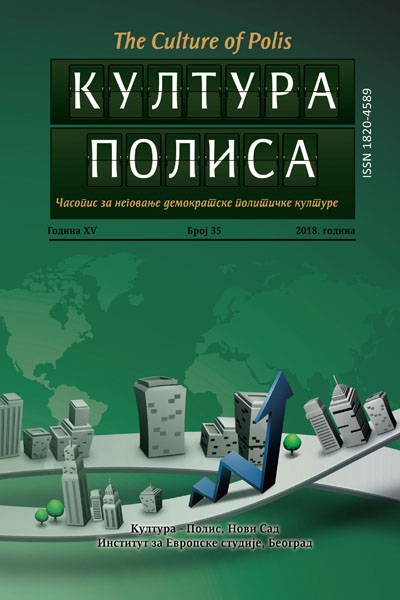OTPORNOST, DOBROBIT I DRUŠTVENI KAPITAL:SADEJSTVA I KOLIZIJE
Ključne reči:
отпорност, добробит, друштвени капитал, јавна политика, квалитет животаApstrakt
Људско деловање усмерава заједничке вредности и процене сврсисходности деловања, тј. просуђивање у духу тих вредности, а у сржи његове мотивације је добробит као квалитет живота. Индивидуална и друштвена добробит формирају се под утицајем бројних фактора чији међусобни однос формира широки дијапазон — од природних околности до друштвено конструисаних норми.
Концепт отпорности је блиско повезан са концептима добробити и друштвеног капитала. У овом раду се представљају начини на који су наведени концепти повезани и њихови заједнички предиктори. Циљ рада је да разматрањем различитих аспеката отпорности укаже на могућности интервенције путем креирања социјалних политика које би биле засниване на бољем разумевању начина на који отпорност, добробит и друштвени капитал универзално функционишу — на нивоу појединца и на нивоу заједнице.
##plugins.generic.usageStats.downloads##
Reference
Adger, N. (2000): Social and Ecological Resilience: Are They Related? Progress in Human Geography. 24(3): 347–364.
Adger, N. et al. (2002): Migration, Remittances, Livelihood Trajectories, and Social Resilience. AMBIO: A Journal of the Human Environment. 31(4): 358–366.
Adger, N. (2003): Social Capital, Collective Action, and Adaptation to Climate Change. Economic Geography. 79(4): 387–404.
Bernheim, B. D. (2010): Bihevioristička ekonomija blagostanja. Panoeconomicus. 2: 123–151.
Bonanno, G. (2004): Loss, trauma, and human resilience: have we underestimated the human capacity to thrive after extremely aversive events? American Psychology. 59(1): 20–8.
Brdar, I. (2006) Životni ciljevi i dobrobit: Je li za sreću važno što želimo? Društvena istraživanja: časopis za opća društvena pitanja. 671–691.
Булатовић, А. (2014): Well–being, Capabilities and Philosophical Practice. Филозофија и друштво. 25(4): 105–120.
Bourdieu, P. (1986) The forms of capital, in Richardson John (ed.), Handbook of Theory and Research for the Sociology of Education. New York.: Greenwood Press. 241–258.
Chandler J., Lalonde C. (1998): Cultural continuity as a hedge against suicide in Canada’s First Nations.Transcultural Psychiatry. 35:191–219.
Dasgupta, P. (2003): Social Capital and Economic Performance: Analytics. Foundations of Social Capital. Critical Studies in Economic Institutions 2: 309–339.
Diener, E. (Ed.). (2009): Social indicators research series: Vol. 38. Culture and well–being: The collected works of Ed Diener.
Kawachi. I, Berkman F. (2001): Social ties and mental health. Journal of Urban Health: Bulletin of the New York Academy of Medicine. 78(3): 458–467.
Kessel, G., Gibbs, L. Mac Dougall, C. (2014): Strategies to enhance resilience post– natural disaster: a qualitative study of experiences with Australian floods and fires. Journal of Public Health. 37( 2): 328–336.
Ledogar, R., Fleming, J. (2008): Social Capital and Resilience: A Review of Concepts and Selected Literature Relevant to Aboriginal Youth Resilience Research. Pimatisiwin. Summer. 6(2): 25–46.
Manyena, S. (2006): The Concept of Resilience Revisited. Disasters. 30(4): 433–50.
Masten, A. (2001): Ordinary magic: Resilience processes in development. American Psychologist. 56(3): 227–238.
Mguni, N, Bacon N, Brown J. F. (2012): The Wellbeing and Resilience Paradox, The Young Foundation.
Mguni, N. i Bacon, N. (2010): Taking the temperature of local communities The Wellbeing and Resilience Measure (WARM). The Young Foundation.
Pavićević, O. (2012): Pozitivni i negativni aspekti društvenog kapitala — slučaj postkomunističkih društava. Sociologija. 54(3): 501–526.
Pelling, M., High. C. (2005) Understanding Adaptation: What Can Social Capital Offer Assessments of Adaptive Capacity? Global Environmental Change. 15 (4): 308–319.
Portes, A. (1998): Social Capital: Its Origins and Applications in Modern Sociology. Annual Review of Sociology. 24: 1–24.
Portes, A., Landolt, P. (1996): The Downside of Social Capital, American Prospect. 26: 18–22.
Putnam, R. (1993) Making Democracy Work: Civic Traditions in Modern Italy. Princeton University Press, Princeton, NJ.
Putnam, R. (2000): Bowling Alone: Collapse and Revival of American Community. New York: Simon&Schuster.
Scheffran, J., Marmer, E., Sow, P. (2012): Migration as a Contribution to Resilience and Innovation in Climate Adaptation: Social Networks and Co–development in Northwest Africa. Applied Geography. 33: 119–127.
Smith, J., Anderson, D., Moore, R. (2012): Social Capital, Place Meanings, and Perceived Resilience to Climate Change. Rural Sociology. 77(3): 380–407.
Ungar, M. (2011): Social Ecologies and Their Contribution to Resilience. In the Scoial Ecology of Resilience. A Handbook of Theoy and Practice. Springer. 13–31.
Wolf, J., Adger, N., Lorenzoni, V., Abrahamson,V., Raine, R. (2010): Social Capital, Individual Responses to Heat Waves and Climate Change Adaptation: An Empirical Study of Two UK Cities.Global Environmental Change. 20 (1): 44–52.
Woolcock M., Narayan D. (2000): Social Capital: Implications for Development Theory, Research and Policy. World Bank Research Observer.
Интернет извори:
Aldrich, D., Smith. R. (2015): Social Capital and Resilience. World Humanitarian Summit (WHS) Policy Brief. http://works.bepress.com/daniel_aldrich/31/.
Healy, S. (2006) Cultural resilience, identity and the restructuring of political power in Bolivia. Paper Submitted for the 11th Biennial Conference of the International Association for the Study of Common Property; Bali, Indonesia. June 19–June 23, 2006; http://www.indiana.edu/~iascp/bali/papers/Healey_susan.pdf.















